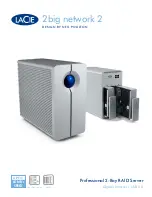
PlatinumRAID Owner’s Manual
1
and 5 volume sets must be initialized to generate parity information. PlatinumRAID features
both foreground and background initialization modes for RAID 3 and RAID 5 volumes- In
background mode, the initialization proceeds as a background task and the volume set is
fully accessible for system reads and writes without requiring a reboot and waiting for the
initialization completion. Furthermore, the RAID volume set is also protected against a single
disk failure while initialing. Background initialization takes longer to complete and host disk
access will be slower during the initialization process. Foreground Initialization must be
completed before the volume set ready for system accesses, but the format is faster.
Array Roaming
The RAID subsystem stores configuration information both in NVRAM and on the disk drives,
and can protect the configuration settings in the case of a disk drive or controller failure. Array
roaming allows the administrator the ability to move a complete RAID set to another system
without losing RAID configuration and data on that RAID set. Should the PlatinumRAID
enclosure cease to function, the RAID set disk drives can be moved to another PlatinumRAID,
inserted in any order, and become instantly available.
Online RAID Level and Stripe Size Migration
Users can migrate both the RAID level and stripe size of an existing volume set, while the
PlatinumRAID is online and the volume set is in use. Online RAID level/stripe size migration
can prove helpful during performance tuning activities as well as at the addition of physical
disks to the RAID subsystem. For example, in a system using two drives in RAID level 1, you
could add capacity and retain fault tolerance by adding one drive. With the addition of third
disk, you have the option of adding this disk to your existing RAID logical drive by migrating
from RAID level 1 to 5. The result would be parity fault tolerance and double the available
capacity without taking the system offline.
Hot Spare Drives
A hot spare drive is an unused online available drive, which is ready for replacing a failed
disk drive. In a RAID level 1, 0+1, 3, or 5 RAID set, any unused online available drive installed
but not belonging to a RAID set can be defined as a hot spare drive. Hot spares permit you
to replace failed drives automatically without powering down your PlatinumRAID. When
your PlatinumRAID detects a drive failure, the system will automatically and transparently
rebuild using any available hot spare drive(s). The RAID set will be reconfigured and rebuilt
in background, while the RAID subsystem continues to handle system requests. During the
automatic rebuild process, system activity will continue as normal, but system performance and
fault tolerance will be affected.
Hot-Swap Disk Rebuild
A Hot-Swap function can be used to rebuild disk drives in arrays with data redundancy such
as RAID level 1(0+1), 3, and 5. If a hot spare is not available at time of drive failure, the failed
disk drive must be replaced with a new disk drive so that the data on the failed drive can
be rebuilt. If a hot spare is available, the rebuild starts automatically when a drive fails. The
RAID subsystem automatically and transparently rebuilds failed drives in the background with
user-definable rebuild rates. The RAID subsystem will automatically restart the system and
the rebuild if the system is shut down or powered off abnormally during a reconstruction
procedure condition. Please note that the system may no longer be fault tolerant during
degraded operation or the rebuild process- Fault tolerance will be lost until the damaged drive
is replaced and the rebuild operation is completed.
2-Understanding RAID
















































